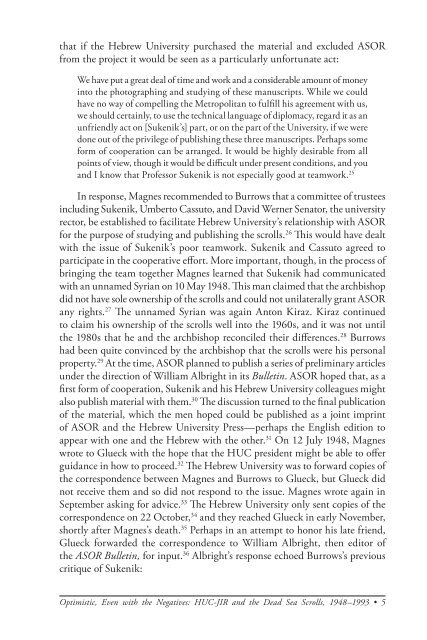The American Jewish Archives Journal, Volume LXI 2009, Number 1
The American Jewish Archives Journal, Volume LXI 2009, Number 1
The American Jewish Archives Journal, Volume LXI 2009, Number 1
Create successful ePaper yourself
Turn your PDF publications into a flip-book with our unique Google optimized e-Paper software.
that if the Hebrew University purchased the material and excluded ASOR<br />
from the project it would be seen as a particularly unfortunate act:<br />
We have put a great deal of time and work and a considerable amount of money<br />
into the photographing and studying of these manuscripts. While we could<br />
have no way of compelling the Metropolitan to fulfill his agreement with us,<br />
we should certainly, to use the technical language of diplomacy, regard it as an<br />
unfriendly act on [Sukenik’s] part, or on the part of the University, if we were<br />
done out of the privilege of publishing these three manuscripts. Perhaps some<br />
form of cooperation can be arranged. It would be highly desirable from all<br />
points of view, though it would be difficult under present conditions, and you<br />
and I know that Professor Sukenik is not especially good at teamwork. 25<br />
In response, Magnes recommended to Burrows that a committee of trustees<br />
including Sukenik, Umberto Cassuto, and David Werner Senator, the university<br />
rector, be established to facilitate Hebrew University’s relationship with ASOR<br />
for the purpose of studying and publishing the scrolls. 26 This would have dealt<br />
with the issue of Sukenik’s poor teamwork. Sukenik and Cassuto agreed to<br />
participate in the cooperative effort. More important, though, in the process of<br />
bringing the team together Magnes learned that Sukenik had communicated<br />
with an unnamed Syrian on 10 May 1948. This man claimed that the archbishop<br />
did not have sole ownership of the scrolls and could not unilaterally grant ASOR<br />
any rights. 27 <strong>The</strong> unnamed Syrian was again Anton Kiraz. Kiraz continued<br />
to claim his ownership of the scrolls well into the 1960s, and it was not until<br />
the 1980s that he and the archbishop reconciled their differences. 28 Burrows<br />
had been quite convinced by the archbishop that the scrolls were his personal<br />
property. 29 At the time, ASOR planned to publish a series of preliminary articles<br />
under the direction of William Albright in its Bulletin. ASOR hoped that, as a<br />
first form of cooperation, Sukenik and his Hebrew University colleagues might<br />
also publish material with them. 30 <strong>The</strong> discussion turned to the final publication<br />
of the material, which the men hoped could be published as a joint imprint<br />
of ASOR and the Hebrew University Press—perhaps the English edition to<br />
appear with one and the Hebrew with the other. 31 On 12 July 1948, Magnes<br />
wrote to Glueck with the hope that the HUC president might be able to offer<br />
guidance in how to proceed. 32 <strong>The</strong> Hebrew University was to forward copies of<br />
the correspondence between Magnes and Burrows to Glueck, but Glueck did<br />
not receive them and so did not respond to the issue. Magnes wrote again in<br />
September asking for advice. 33 <strong>The</strong> Hebrew University only sent copies of the<br />
correspondence on 22 October, 34 and they reached Glueck in early November,<br />
shortly after Magnes’s death. 35 Perhaps in an attempt to honor his late friend,<br />
Glueck forwarded the correspondence to William Albright, then editor of<br />
the ASOR Bulletin, for input. 36 Albright’s response echoed Burrows’s previous<br />
critique of Sukenik:<br />
Optimistic, Even with the Negatives: HUC-JIR and the Dead Sea Scrolls, 1948–1993 • 5

















